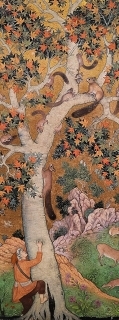Seeing things from a different perspective at South Kensington
AN EXHIBITION AT LONDON’S Victoria and Albert Museum, which is showing until 5 May 2025, displays works of art created in the Moghul Empire between about 1560 and 1660, a period in which the Emperors Akbar, Jahangir and Shah Jahan reigned. Apart from wonderful jewels, jewellery, jewel-encrusted swords, and various other luxurious items, the exhibition contains a superb array of painted miniatures. Each one of these meticulously painted images is filled with a wealth of detail, and depict people as well as scenes of (often) courtly life.

The miniature paintings differ from those created in Western Europe (notably in Italy, France, Germany, and the Low Countries) during that period in many ways. One of these differences is the portrayal of perspective. To the eyes of people used to looking at Western European paintings of the late sixteenth and early seventeenth centuries, the Mughal miniatures seem to lack any obvious portrayal of perspective when compared to what was being painted at the same time in Western Europe.
Many of us living in the twenty-first century are accustomed to seeing perspective portrayed in the way it has been done since the fifteenth century, when it was pioneered by the architect and engineer Filippo Brunelleschi, who rediscovered what the Ancient Greeks and Romans knew already. While I was looking at the Mughal miniatures, I wondered whether people who were living in the Mughal Empire at the time when they were painted saw the images in a different way to us, who are used to having perspective ‘spelled out’ or depicted in the Western European way. Did they look at the paintings and understand the perspective, without it having to be emphasised as it is in European art? Did their experience of life, as it was, allow them to understand the spatial relationships of the subject matter depicted in the paintings, or would it have seemed to lack depth as it does when we look at it today? Or was the subject matter more important to them than how it looked in ‘real life’?



